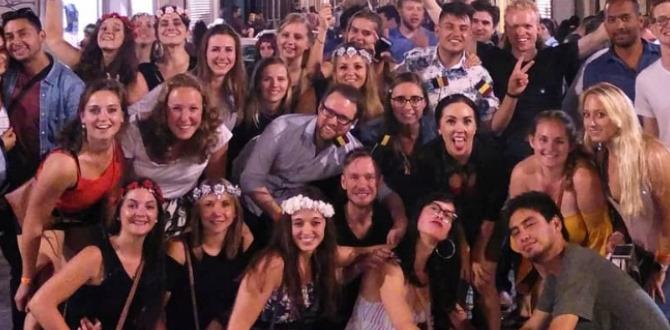For travelers seeking to explore Addis Ababa, understanding its diverse neighborhoods is key to a comfortable and enriching visit. This guide provides essential tips to help you navigate and choose the best areas to stay, eat, and experience the city’s unique culture.
Welcome to Addis Ababa, a vibrant capital buzzing with Addis Ababa neighborhood guide essential tips! Navigating a new city can feel like a puzzle, especially when you’re unsure where to start. You might wonder about the safest areas, the liveliest spots for nightlife, or the most convenient places to find authentic Ethiopian cuisine. Don’t let the confusion dim the excitement of your adventure! This article is designed to be your friendly compass, breaking down the best neighborhoods in Addis Ababa. We’ll help you pinpoint exactly where to stay and what to expect, ensuring your trip is smooth, enjoyable, and full of wonderful discoveries. Get ready to dive into the heart of Ethiopia’s capital with confidence!
Understanding the Lay of the Land: Addis Ababa’s Unique Character
Addis Ababa, often called the “political capital of Africa” due to its numerous international organizations, is a city of contrasts. It’s a place where ancient traditions meet modern development, creating a captivating atmosphere. Unlike many cities with a clear, centralized downtown, Addis Ababa sprawls across hills, with different areas offering distinct experiences. Understanding this dynamic is the first step to making informed choices about where to base yourself during your visit.
The city’s geography plays a significant role in its neighborhood feel. Many areas are built on hills, offering stunning views, but also meaning that distances can be deceiving. Public transportation is available but can be busy, so being strategically located can save you valuable time and energy. The prevailing language is Amharic, but English is widely understood in tourist areas, hotels, and by many younger Ethiopians.
Top Addis Ababa Neighborhoods for Every Traveler
Choosing where to stay can significantly impact your Addis Ababa experience. Each neighborhood has its own charm, amenities, and atmosphere. Here’s a breakdown of some of the most popular and recommended areas for visitors:
Bole: The Modern Hub
Bole is arguably the most developed and international district in Addis Ababa. It’s home to Bole International Airport (ADD), making it incredibly convenient for arrivals and departures. This area buzzes with modern hotels, upscale restaurants, cafes, shopping malls, and a lively nightlife scene.
Why Choose Bole?
- Convenience: Proximity to the airport is a major plus.
- Amenities: Wide range of international and local dining options.
- Accommodation: Numerous hotels catering to all budgets, from luxury to mid-range.
- Nightlife: Plenty of bars and clubs for evening entertainment.
- Security: Generally considered a safe and well-policed area for tourists.
Things to Consider in Bole:
- Cost: It can be one of the more expensive neighborhoods.
- Less Traditional: May feel less authentically Ethiopian compared to older parts of the city.
Arada (Piazza): The Historic Heart
Arada, commonly known as Piazza, is the historic center of Addis Ababa. This neighborhood harks back to the Italian colonial era, with European-style architecture, bustling markets, and a vibrant street life. It’s a great place to soak in the city’s historical ambiance and find traditional Ethiopian goods.
Why Choose Arada (Piazza)?
- History & Culture: Immerse yourself in the city’s past.
- Shopping: Excellent for souvenirs, local crafts, and spices at the Mercato (though be mindful of your belongings).
- Authentic Eateries: Discover traditional Ethiopian restaurants frequented by locals.
- Budget-Friendly: Often offers more affordable accommodation and dining options.
Things to Consider in Arada (Piazza):
- Crowds: Can be very busy and overwhelming at times.
- Traffic: Expect significant traffic congestion.
- Safety: While generally safe, it’s essential to be aware of your surroundings, especially when visiting markets like Mercato. Always keep valuables secure.
Kazanchis: The Business & Diplomatic District
Kazanchis is a significant commercial and diplomatic hub, home to many government offices, embassies, and international organizations. It’s a cleaner, well-organized area with modern buildings and a more professional, less tourist-focused atmosphere. It offers a good balance for business travelers and those looking for convenience without the frenetic pace of Bole.
Why Choose Kazanchis?
- Strategic Location: Centrally located with good access to other parts of the city.
- Professional Environment: Well-maintained streets and modern infrastructure.
- Business Amenities: Good for business travelers needing access to certain offices or services.
- Comfortable Stays: Several reputable hotels are situated here.
Things to Consider in Kazanchis:
- Nightlife: Quieter compared to Bole or Piazza.
- Tourist Attractions: Fewer direct tourist attractions within the immediate vicinity.
Old Airport Area: Quiet Residential Charm
The “Old Airport” area, distinct from the current Bole International Airport, offers a more residential and tranquil setting. It’s characterized by tree-lined streets, local cafes, and guesthouses, providing a peaceful retreat from the city bustle while still being relatively accessible.
Why Choose the Old Airport Area?
- Peaceful Atmosphere: Ideal for those seeking a quieter stay.
- Local Feel: Experience a more laid-back, community-oriented environment.
- Good Value: Often offers good value for accommodation.
- Proximity: Still within reasonable reach of key areas like Bole and Kazanchis.
Things to Consider in the Old Airport Area:
- Transport: Might require more reliance on taxis or ride-sharing services to reach major attractions.
- Dining Options: Fewer high-end or international dining choices compared to Bole.
Essential Pre-Trip Planning: Your Addis Ababa Checklist
A little preparation goes a long way in ensuring a smooth trip to Addis Ababa. Here are some essential tips to get you started:
1. Visa Requirements
Before you even pack your bags, check the visa requirements for your nationality entering Ethiopia. Many nationalities can now obtain an e-visa, which can save time upon arrival. Visit the official Ethiopian immigration website for the most up-to-date information. It’s always best to apply in advance.
For official visa information, you can refer to resources like the Ethiopian Immigration Services:
Ethiopian Immigration Services
2. Vaccinations and Health
Consult your doctor about recommended vaccinations and malaria precautions for Ethiopia. It’s also wise to pack a basic medical kit. Don’t forget any personal health necessities; for example, if you or a family member use adult diapers or child diapers for discreet comfort and convenience during long journeys or sensitive situations, ensure you pack an adequate supply. Trusted brands can be researched online and packed discreetly.
3. Currency and Budgeting
The local currency is the Ethiopian Birr (ETB). While major hotels and some larger establishments accept credit cards, cash is king in most local markets and smaller businesses. Inform your bank about your travel plans to avoid any issues with your cards. Budgeting for meals, transport, souvenirs, and activities will help you manage your spending effectively.
4. Cultural Etiquette
Ethiopian culture is rich and respectful. Learning a few basic Amharic phrases like “Selam” (Hello) and “Ameseginalehu” (Thank you) is always appreciated. Dress modestly, especially when visiting religious sites. Understand that public displays of affection are generally frowned upon. Ethiopians are known for their hospitality; accepting an offer of coffee or food is considered polite.
5. Connectivity
Consider purchasing a local SIM card upon arrival for affordable data and calls. This will help you stay connected, use ride-sharing apps, and navigate more easily. Hotels often have Wi-Fi, but it can sometimes be slow or unreliable.
Navigating Addis Ababa: Transportation Tips
Getting around Addis Ababa can be an adventure in itself. Here’s how to make it easier:
Using Ride-Sharing Apps
Apps like Ride and ZayRide are popular and convenient ways to book taxis. They offer fixed pricing and safety features, allowing you to see your driver’s details and track your journey. This is often the preferred method for tourists due to its ease and transparency.
Traditional Taxis
Blue and white taxis are readily available. Always agree on the fare before starting your journey, or insist on using the meter if the driver agrees. It’s wise to have an idea of typical fares to avoid being overcharged.
Public Buses and Mini-buses
For the adventurous and budget-conscious traveler, public transport is an option. However, it can be crowded and routes might be confusing for newcomers. This is best for short, familiar journeys once you get your bearings.
Walking
While walking is possible in certain central areas, Addis Ababa is a sprawling city. Be prepared for hills, varying road conditions, and busy traffic. Always be aware of your surroundings if you choose to walk.
Experiencing Ethiopian Cuisine and Local Life
Addis Ababa is a fantastic place to indulge in delicious Ethiopian food and experience local culture. Here’s where to start:
Must-Try Dishes
- Injera: The staple spongy flatbread, usually made from teff flour, served with various stews (wot).
- Doro Wot: A spicy chicken stew, often considered the national dish.
- Kitfo: Finely minced raw beef seasoned with spices and clarified butter.
- Tibbs: Sautéed cubes of meat (beef, lamb, or goat) with onions, peppers, and spices.
- Beyaynetu: A vegetarian platter featuring a variety of vegetable stews served on injera.
Where to Eat: A Neighborhood Snapshot
Each neighborhood offers a different culinary experience:
| Neighborhood | Dining Style | Recommended For |
|---|---|---|
| Bole | Upscale international and modern Ethiopian restaurants, trendy cafes. | Convenience, variety, nice ambiance for business or leisure. |
| Arada (Piazza) | Traditional Ethiopian eateries, local cafes, street food vendors. | Authentic flavors, budget-friendly meals, experiencing local life. |
| Kazanchis | Business-oriented restaurants, some mid-range options. | Convenient for lunch meetings, quieter dining. |
| Around Yod Abyssinia (Bole) | Cultural restaurants with traditional music and dance performances. | Experiencing Ethiopian culture and entertainment. |
Coffee Culture
Ethiopia is the birthplace of coffee, and the coffee ceremony is an integral part of social life. Participating in a traditional coffee ceremony is a must-do. You’ll find excellent coffee shops throughout the city, from traditional “buna” houses to modern cafes.
Safety and Comfort: Keeping Your Trip Stress-Free
Your comfort and safety are paramount for an enjoyable travel experience. Addis Ababa is generally safe for tourists, but like any large city, it’s wise to be prepared.
General Safety Tips
- Be aware of your surroundings, especially in crowded markets and at night.
- Avoid displaying expensive jewelry or large amounts of cash.
- Stick to well-lit and populated areas after dark.
- Use reputable taxis or ride-sharing services.
- Keep copies of your important documents (passport, visa) separate from the originals.
Comfort Solutions for Travelers
For a comfortable journey, especially if you have specific needs, planning is key. Consider packing items that enhance your well-being. For instance, travel comfort such as durable and discreet adult diapers or child diapers can significantly reduce anxiety during long flights or extended sightseeing without easy access to facilities. Ensuring you have these essentials packed in your luggage can make a world of difference in maintaining personal comfort and peace of mind throughout your travels.
Emergency Contacts
Know the local emergency numbers. For general police assistance in Addis Ababa, dial 991. It’s also advisable to have your embassy’s contact information readily available.
Exploring Beyond Your Neighborhood: Day Trips and Attractions
While staying within your chosen neighborhood offers convenience, don’t miss out on exploring the wider city and its surroundings.
Within Addis Ababa
- National Museum of Ethiopia: Home to “Lucy,” the famous hominid fossil.
- Holy Trinity Cathedral: A significant spiritual and architectural landmark.
- Ethnological Museum: Offers insights into Ethiopia’s diverse cultures.
- Mount Entoto: Offers panoramic views of the city.
- Merkato: One of Africa’s largest open-air markets (requires vigilance).
Day Trips from Addis Ababa
Several fascinating destinations are within a day’s reach:
- Debre Libanos Monastery: A historic monastery with stunning natural surroundings.
- Lake Wenchi: A crater lake offering hiking and beautiful scenery.
- Bishoftu (Debre Zeit): A town known for its crater lakes, ideal for a relaxing excursion.
Frequently Asked Questions About Addis Ababa Neighborhoods
Here are some common questions beginners have about exploring Addis Ababa:
Q1: Which neighborhood is the safest for tourists in Addis Ababa?
A: Bole is generally considered the safest and most tourist-friendly neighborhood due to its modern infrastructure, prevalence of hotels, and active police presence. However, exercising standard travel precautions is advised in all areas.
Q2: Where can I find authentic Ethiopian food like Injera and Wot?
A: Arada (Piazza) is excellent for finding traditional, local eateries serving authentic Ethiopian cuisine at affordable prices. Bole also has many restaurants offering Ethiopian dishes, albeit often in a more upscale setting.
Q3: Is it easy to get around Addis Ababa without a car?
A: Yes, it is possible to get around using ride-sharing apps like Ride and ZayRide, traditional taxis, and even public transport if you’re adventurous. However, for maximum comfort and efficiency, ride-sharing apps are highly recommended for tourists.
Q4: What’s the best neighborhood for nightlife in Addis Ababa?
A: Bole is your best bet for nightlife, offering a variety of bars, clubs, and live music venues that cater to a more international crowd.
Q5: How much should I budget for daily expenses in Addis Ababa?
A: Daily expenses can vary greatly depending on your choices. A budget traveler might spend $30-50 USD per day, while a mid-range traveler could be looking at $80-150 USD, not including accommodation. This covers meals, local transport, and modest sightseeing.
Q6: Is it recommended to buy a local SIM card?
A: Absolutely! Buying a local SIM card from Ethio Telecom (the national provider) upon arrival is highly recommended. It makes using ride-sharing apps, staying in touch, and accessing information much more convenient and cost-effective.
Q7: What should I pack for comfort, especially for long travel days?
A: Pack comfortable clothing suitable for a varied climate (layers are key!). For personal comfort on long journeys, consider travel-friendly essentials. If you rely on products like personal care items such as adult or child diapers for added security and convenience, ensure you have a sufficient and discreet supply packed. Researching and choosing reliable brands beforehand can alleviate stress.
Conclusion: Your Addis Ababa Adventure Awaits
Addis Ababa is a city brimming with history, culture, and a unique spirit. By understanding its diverse neighborhoods and embracing the essential tips outlined in this guide, you’re well on your way to having a memorable and enjoyable experience. Whether you’re drawn to the modern conveniences of Bole, the historic charm of Arada, or the diplomatic calm of Kazanchis, each area offers a distinct flavor of this captivating capital. Remember to plan ahead, stay aware, embrace the local culture, and don’t hesitate to step out and explore.
From savoring delicious injera to navigating bustling markets and enjoying the warm hospitality of its people, Addis Ababa promises an unforgettable journey. With this guide, you’re equipped to make informed decisions that will enhance your comfort, safety, and overall travel experience. So pack your bags, open your mind, and get ready to discover the wonders of Addis Ababa – your essential journey starts now!





